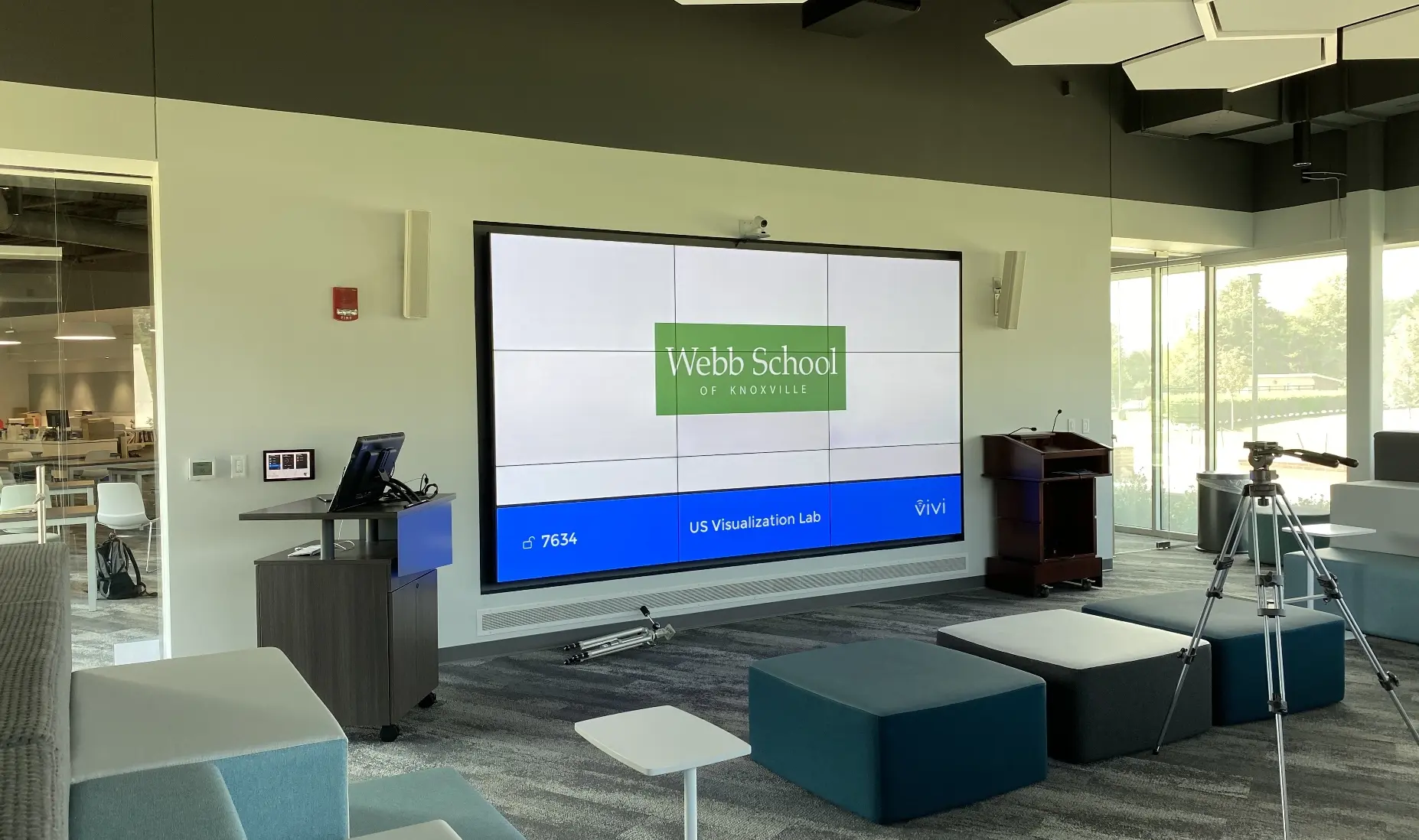
There are few things more critical in today’s learning environment than versatility. On a school campus, digital signage has now become an essential part of disseminating information, although there is still room for improvement within the rapidly evolving world of EdTech. While the DIY approach to digital signage has helped many schools take enormous leaps forward, does that mean that DIY is the right way for every school campus? Are there more straightforward, cost-effective solutions that don’t require system-wide upgrades?
Because managing a school’s EdTech is a delicate and unpredictable process, staying current on industry trends is a key to efficiency and overall performance. To that end, regularly evaluating your digital signage system is vital in determining whether your system is the best option for your school district. A DIY-based digital signage system may be an excellent first step into the digital world. Still, more versatile EdTech solutions can open the door to higher efficiency and more robust student engagement while tapping the full potential of the wireless era.
The draw of DIY digital signage in a school setting
The original plug-and-play model of a simple screen and an HDMI cord was a game-changer. For relatively low upfront costs, school districts were able to provide a quick digital uplift the same way that small businesses could. Even tech-hesitant administrators could easily see the benefits of a few well-placed screens that could project important announcements to the student populous. Ultimately, digital technology can provide uninterrupted access to critical and current information, one of the key advantages of modern tech in the classroom setting.
Other reasons that schools have adopted a DIY digital signage approach include:
- Ostensibly straightforward budgeting impact
- Easy way to showcase transition to digital
- Tapping the image vs. text dynamic
- Inclusivity
Clarity is key in school budgets, so straightforward DIY solutions have been widely used in the digital shift. For administrators keenly aware of the impact of atmosphere on students, shifting into the digital world was (and is) an enormous challenge given limited resources and the complexity of a school district. But basic DIY digital signage systems were easy to quantify, implement, and monitor in the early stages of the transformation.
RELATED: Can Free Digital Signage Solutions Deliver What They Promise to Schools?
Within that essential upgrade, schools could tap a fundamental messaging theme: images can have a far more significant impact on students than text. Studies show that the human brain can process an image 30 times faster than in the blink of an eye. Meanwhile, students all read at different levels, and even the best readers still process text dramatically slower than images.
In a hyperactive environment like a school or campus, regularly updated digital signs heavy on imagery can cut through the noise and send critical messages to a diverse student population in real-time. This facilitates a much more inclusive environment that administrators can endlessly customize to fit the school or campus.
Advantages of DIY signage turning into disadvantages
As with nearly any form of technology, what starts at the front end of the tech curve doesn’t stay there forever. The first simple digital signage systems that popped up around school districts felt like a revolution, but now the tech has moved on, and new opportunities and challenges have arisen. The biggest concern: DIY systems requiring manual message updates can inherently limit the potential of the Wi-Fi era just as wireless technology reaches maturity.
This is because the world of today moves faster than ever before. While an outdated digital message on display can make the system seem antiquated, lacking the ability for immediate district-wide messaging also makes little sense in the age of Wi-Fi. Weather changes, bus-schedule updates, and safety alerts are sent instantly district-wide to parents. Yet, school officials often can’t send these same valuable updates directly to the halls where students roam.
Within the many challenges of a decentralized signage system is the importance of keeping students engaged and inclusive. Centralized solutions that harness the power of Wi-Fi and seamlessly perform updates can make decentralized systems seem less current. No one picks up on lagging tech faster than students born in the digital age. Kids don’t just see screens and digital messaging in their schools; they see them in medical and sports facilities, in theaters and in play centers. When students perceive that their school is falling behind, retaining engagement can be more complex than it has to be.
Are DIY digital signage options able to handle complex messaging systems?
One of the chief advantages of digital technology is the incredible opportunity for versatility and customization. While DIY systems can still customize reasonably well on a schedule, what happens when the messaging has to change quickly? What do administrators do if they want to send one type of alert to one school and something else to a different one within the district?
The answers here wholly depend on your signage system. School districts using a cohesive, centralized system will be able to seamlessly shift gears and get timely messages to every student or faculty member on campus. Considering students and faculty are rarely on their phones during a school day, digital signage is often far and away the best place to distribute crucial new information. For a school district to balance the interests of different schools and campuses, having the ability to send various updates to other places effortlessly taps the full promise of the digital age.
Meanwhile, school districts relying upon manually operated DIY systems might have to use older communication models for unforeseen updates. You might even have a small team of administrators who have to stop what they’re doing and update the portion of the system they control. And even though a traditional school P.A. system still has many uses, it’s far from ideal for getting critical information to students buzzing about in between classes.
In short, DIY models can work very well on an ordinary day when everything is going well—despite organizational disadvantages compared to a centralized system. However, when things don’t go according to plan, a centralized system can immediately tap features that a DIY system can’t compete with. This is why school IT specialists have been pressing for more centralized solutions to help the entire messaging operation run as a unit.
Planning locations for digital signage
There are many different places where digital signage can have a meaningful impact, although improper placement can also lead to complications within the wrong type of system. Typical areas for digital signage on a school campus include:
- Entryways
- Cafeterias
- Hallways
- Gyms and theaters
- Individual classrooms
Among the best spots for feeling the digital impact, entryways and cafeterias are ideally suited for quickly updated digital messaging. The right sign at an entrance can provide critical information to students and guests, although manually entering messages for every entry can be time-consuming. Meanwhile, Cafeterias are an excellent place to showcase the day’s menu and nutritional info. For younger students, a welcoming digital menu with visuals can help overcome any intimidation that might come with ordering from a menu.
Related: Does Your Interactive Flat Panel for Education Stand Up to Your School District’s Needs?
Other signage needs to be carefully planned to have the most significant impact, but shrewd administrators will also be looking to counter a familiar dilemma: tampering. While signage overseen by a central administrative team will have complete control over the messaging for each unit, DIY systems can be subject to student tampering—especially on less prominent screens. Unsecured screens in less-visible areas might be left to the imaginations of tech-savvy students, which is the stuff of nightmares for administrators.
While digital signage allows for customization throughout the many areas targeted for messaging, the best EdTech of today facilitates cohesive, dynamic messaging while avoiding common problems like tampering.
Cost: DIY versus centralized digital systems
Many school districts stick with DIY signage solutions because they have served them well. Additionally, administrators are always wary of the budgetary impact of a total tech overhaul. Recalling the process of putting in digital screens in the first place, a cautious administrator might believe an upgrade isn’t worth the perceived hassle or expected costs.
But the top EdTech options of today are fluid enough to work directly with existing technology, countering fears of a system-wide upgrade. While making such a meaningful change to a school used to require a high cost and significant disruptions, moving from a DIY signage system to a centralized platform is a very cost-effective and straightforward approach. In a world where even cars require software updates, radical improvements now happen entirely out of view—with minimal or no physical changes.
With the ability to apply new software solutions to older interactive screens, a major upgrade can be as invaluable as unobtrusive. An all-in-one system where automated schedules are simplified requires fewer staff members dedicated to handling communications. Ease of updates should also be a consideration for any administrator looking for sustainable EdTech solutions, one of the key trends in EdTech. Enhanced overall operational efficiency means school administrators can get more out of their current staff and have to provide less digital-messaging training to staff members forced to multitask.
Looking forward to the future of EdTech
While the first wave of digital tech in schools was an unusual step, the next generation of technology promises to complement the old while ushering in the new. As administrators look for sustainable and cost-effective long-term solutions, versatile platforms can offer expanded customization alongside a marked uptick in operational efficiency. Such a centralized approach can make sense of a delicate network of buildings that make up a campus or school district, ultimately putting administrators in real-time control of system-wide messaging. Seamlessly working alongside existing tech, Vivi offers plug-and-play solutions built to last in the changing digital world. Contact Vivi to schedule a demo and see how Vivi’s flexible platform can help any school improve its digital signage system from end to end.



